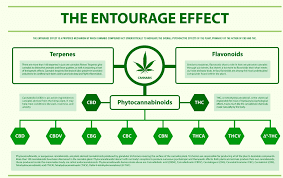The entourage effect is a quintessential concept in the cannabis realm. Shedding light on the synergistic interaction among various compounds present in the plant. It’s not merely about the individual effects of cannabinoids like THC or CBD. But how they harmonize with other substances within cannabis to enhance therapeutic potential.
Defining the Entourage Effect
The entourage effect is the theory that cannabinoids and terpenes, the aromatic compounds found in cannabis, work together to influence each other’s effects and therapeutic properties. When these compounds interact, they can modulate each other’s effects, potentially amplifying the therapeutic benefits and mitigating adverse effects.
Cannabinoids and Terpenes: A Harmonious Interplay
Central to the entourage effect are the interactions between cannabinoids like THC and CBD, and terpenes. Cannabinoids are chemical compounds that can alter neurotransmitter release in the brain. While terpenes are aromatic compounds that define the flavor and aroma of the plant. The marriage of cannabinoids and terpenes can result in enhanced or altered effects, making the whole plant more effective than its isolated compounds.
Implications for Therapeutics
The entourage effect underscores the potential advantages of full-spectrum or broad-spectrum cannabis products over isolates. These products contain a variety of cannabinoids and terpenes, aiming to deliver a more comprehensive therapeutic experience. This symbiotic relationship can potentially offer better pain relief, anxiety reduction, and anti-inflammatory benefits among others.
The entourage effect is a fascinating concept that accentuates the holistic essence of cannabis. It promotes a broader understanding of how the myriad compounds within cannabis interact, paving the path for more effective and potentially safer cannabis-based therapeutics. As research progresses, the entourage effect will undoubtedly continue to play a pivotal role in shaping the future of cannabis medicine.









